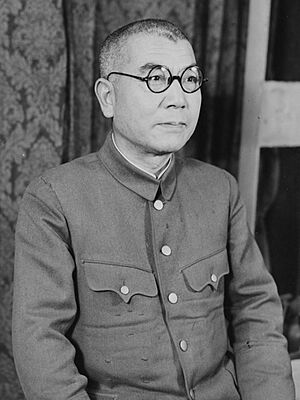Akira Mutō facts for kids
Quick facts for kids
Akira Mutō
|
|
|---|---|

Mutō in 1947
|
|
| Born | 15 December 1892 Hakusui, (present day of Minamiaso, Kumamoto) Japan
|
| Died | 23 December 1948 (aged 56) Sugamo Prison, Tokyo, Occupied Japan
|
| Cause of death | Execution by hanging |
| Criminal status | Executed |
| Conviction(s) | Crimes against peace War crimes |
| Trial | International Military Tribunal for the Far East |
| Criminal penalty | Death |
| Military career | |
| Allegiance | |
| Service/ |
|
| Years of service | 1913–1945 |
| Rank | |
| Commands held | Imperial Guards Division |
| Battles/wars | Second Sino-Japanese War World War II |
Akira Mutō (武藤 章, Mutō Akira, born 15 December 1892 – died 23 December 1948) was a high-ranking general in the Imperial Japanese Army during World War II. After the war, he was found responsible for serious actions that went against the rules of war. He was sentenced to death and died by hanging. Mutō was linked to events where many people suffered, including the Nanjing Massacre and the Manila massacre.
Contents
Biography
Early Life and Military Training
Akira Mutō was born in Hakusui, Kumamoto, Japan. He joined the military at a young age. In 1913, he finished his training at the 25th class of the Imperial Japanese Army Academy. He continued his studies and graduated from the 32nd class of the Army Staff College in 1920.
Time in Germany and Staff Roles
From 1923 to 1926, Mutō worked as a military attaché in Germany. This meant he was a military officer who served in a foreign country to represent his own nation. When he returned to Japan, he held various important jobs. He worked in planning and support roles within the Imperial Army General Staff Office.
Starting the Second Sino-Japanese War
In 1935, Mutō was part of the team that planned military strategies for Japan. He was also the head of military information for the Kwantung Army. This was around the time of the Marco Polo Bridge Incident. This event is believed to have been planned by some military leaders, including Mutō. It was the spark that started the Second Sino-Japanese War.
Role in China and World War II
Mutō became the Vice Chief of Staff for the Japanese Central China Area Army. He was in China during the early parts of the war. He was later accused of leading troops during some very difficult events, including the Nanjing Massacre. In 1939, Mutō was called back to Japan and promoted to major general. He then worked for the Ministry of War.
Just before the Pacific War began, Mutō was promoted again to lieutenant general. He was in charge of military affairs when Japan attacked Pearl Harbor. In April 1942, he was given command of the Second Imperial Guards Division in Singapore. Later, in June 1944, he led Japanese forces on Sumatra in the Netherlands East Indies, which Japan had taken over. In October 1944, he moved to the Philippines. There, he became the chief of staff for the Japanese Fourteenth Area Army under General Tomoyuki Yamashita.
Actions in the Philippines and Trial
In the Philippines, Mutō was accused of ordering actions that caused great harm to civilians and prisoners of war. These actions included violence and mistreatment. He was also accused of ordering harsh measures against local resistance fighters.
After Japan surrendered, Mutō was arrested by the American forces. He was put on trial for war crimes by a special court called the International Military Tribunal for the Far East. He was found responsible for actions that harmed many people, including civilians and captured soldiers, in both China and the Philippines. He was sentenced to death and died by hanging on 23 December 1948.

